Detailed Report: Development and Evolution of the JavaScript Language
VerifiedAdded on 2020/05/16
|9
|1798
|78
Report
AI Summary
This report provides a comprehensive overview of the development and evolution of JavaScript, a scripting language crucial for enhancing web page interactivity. It begins with an executive summary, followed by an introduction highlighting JavaScript's role in client-side data validation and its ability to integrate with various libraries. The report then delves into the language's development, including its designer Brendan Eich, its open-source nature, and its application in web engineering and security. It explores JavaScript's features, such as its object-based nature, control statements, and client-side capabilities, along with code examples. The language evaluation section assesses JavaScript's support for object-oriented programming and its browser compatibility. The report concludes with a summary of JavaScript's evolution and its significance in dynamically modifying HTML webpages, improving user experience, and validating user inputs. References to relevant research papers are also included, providing further context to the development and assessment of JavaScript.
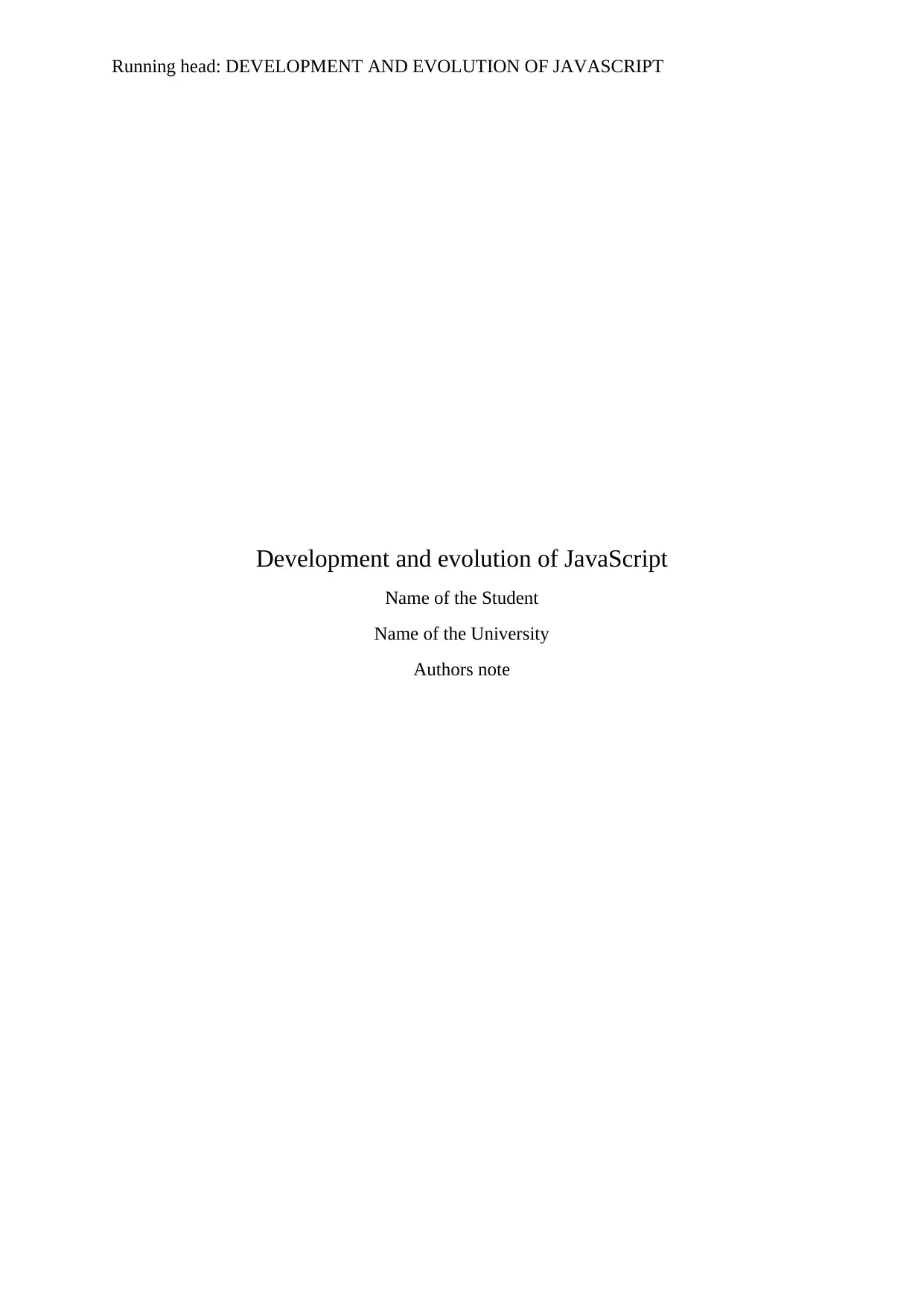
Running head: DEVELOPMENT AND EVOLUTION OF JAVASCRIPT
Development and evolution of JavaScript
Name of the Student
Name of the University
Authors note
Development and evolution of JavaScript
Name of the Student
Name of the University
Authors note
Paraphrase This Document
Need a fresh take? Get an instant paraphrase of this document with our AI Paraphraser
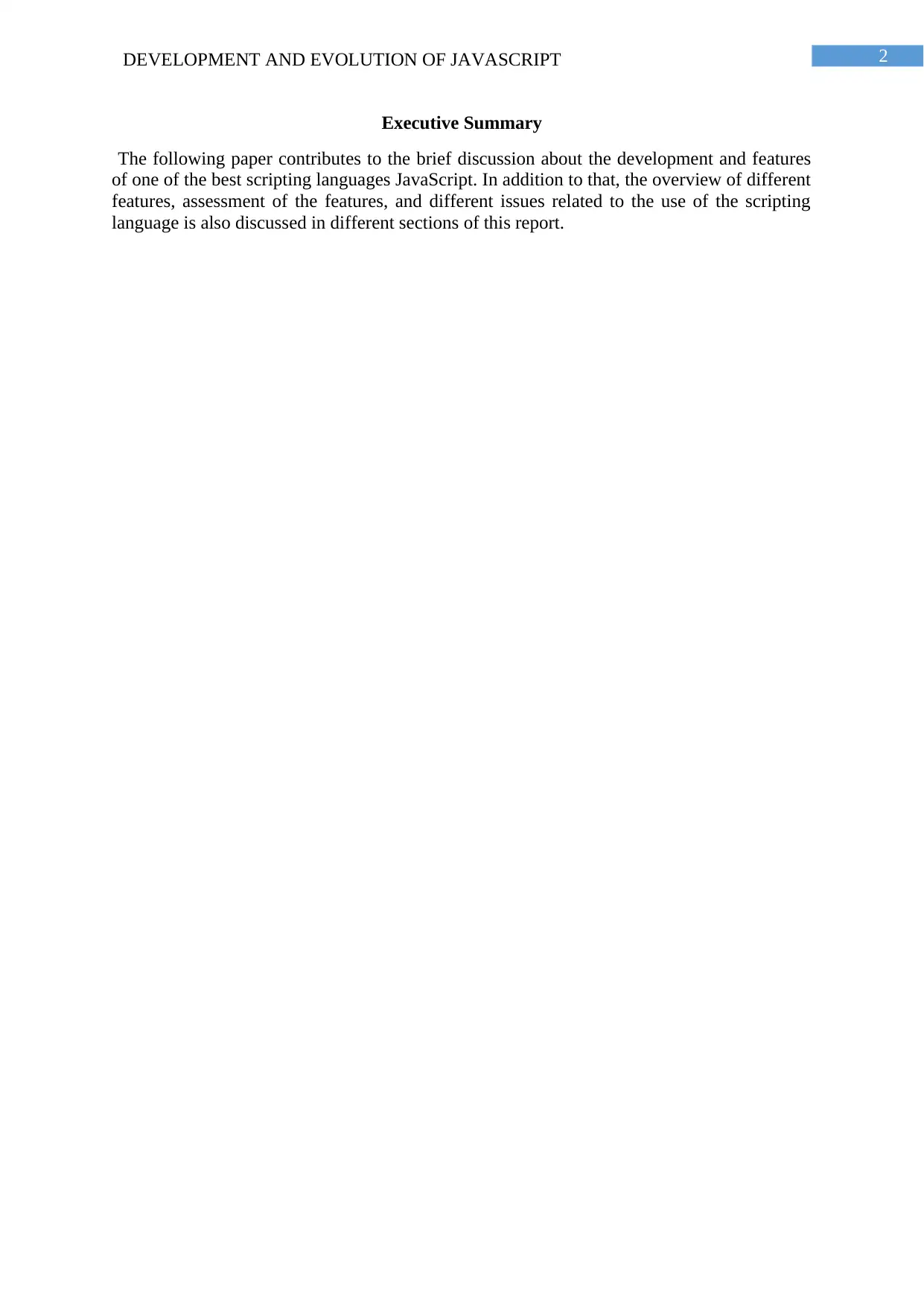
2DEVELOPMENT AND EVOLUTION OF JAVASCRIPT
Executive Summary
The following paper contributes to the brief discussion about the development and features
of one of the best scripting languages JavaScript. In addition to that, the overview of different
features, assessment of the features, and different issues related to the use of the scripting
language is also discussed in different sections of this report.
Executive Summary
The following paper contributes to the brief discussion about the development and features
of one of the best scripting languages JavaScript. In addition to that, the overview of different
features, assessment of the features, and different issues related to the use of the scripting
language is also discussed in different sections of this report.
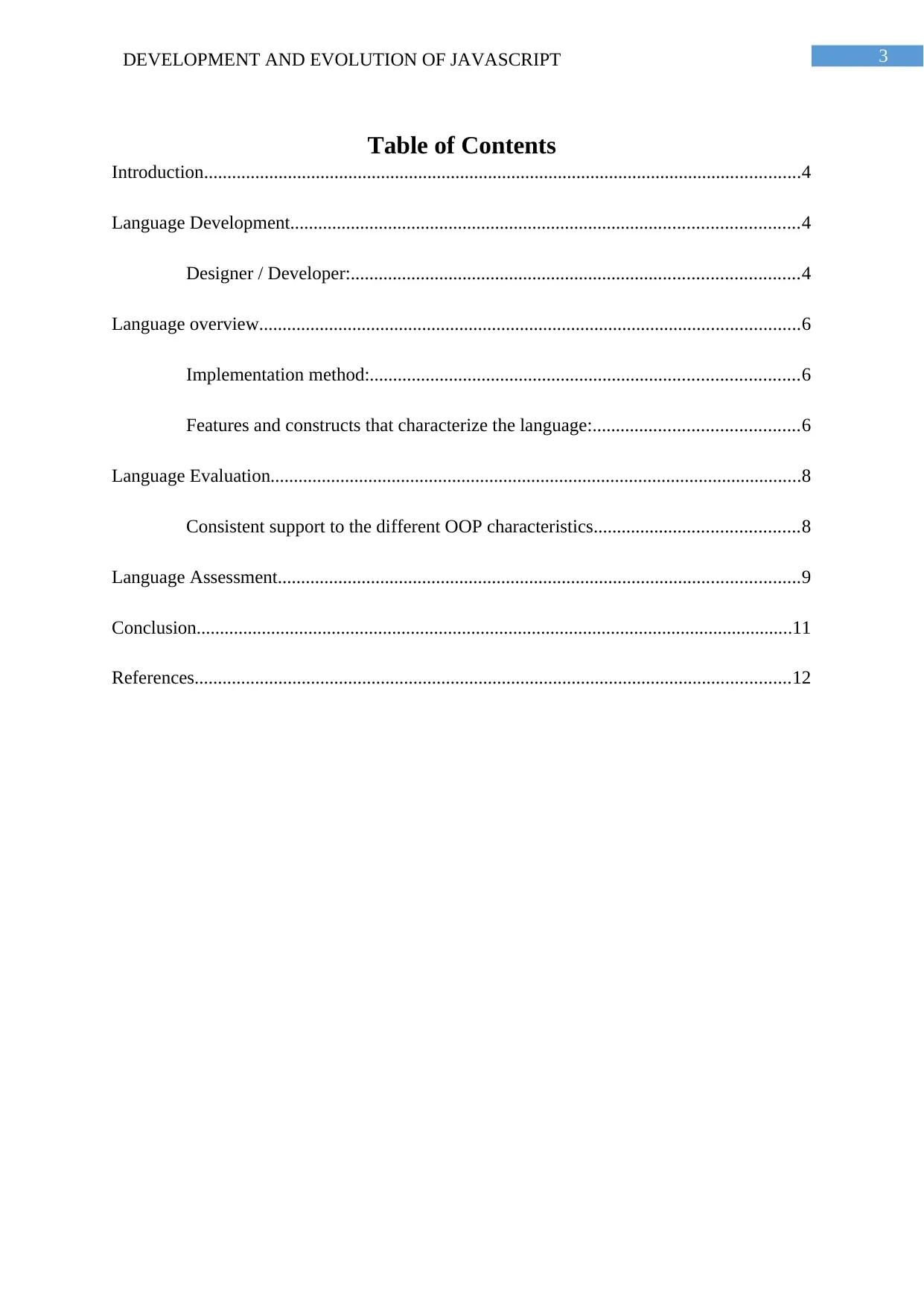
3DEVELOPMENT AND EVOLUTION OF JAVASCRIPT
Table of Contents
Introduction................................................................................................................................4
Language Development.............................................................................................................4
Designer / Developer:................................................................................................4
Language overview....................................................................................................................6
Implementation method:............................................................................................6
Features and constructs that characterize the language:............................................6
Language Evaluation..................................................................................................................8
Consistent support to the different OOP characteristics............................................8
Language Assessment................................................................................................................9
Conclusion................................................................................................................................11
References................................................................................................................................12
Table of Contents
Introduction................................................................................................................................4
Language Development.............................................................................................................4
Designer / Developer:................................................................................................4
Language overview....................................................................................................................6
Implementation method:............................................................................................6
Features and constructs that characterize the language:............................................6
Language Evaluation..................................................................................................................8
Consistent support to the different OOP characteristics............................................8
Language Assessment................................................................................................................9
Conclusion................................................................................................................................11
References................................................................................................................................12
⊘ This is a preview!⊘
Do you want full access?
Subscribe today to unlock all pages.

Trusted by 1+ million students worldwide
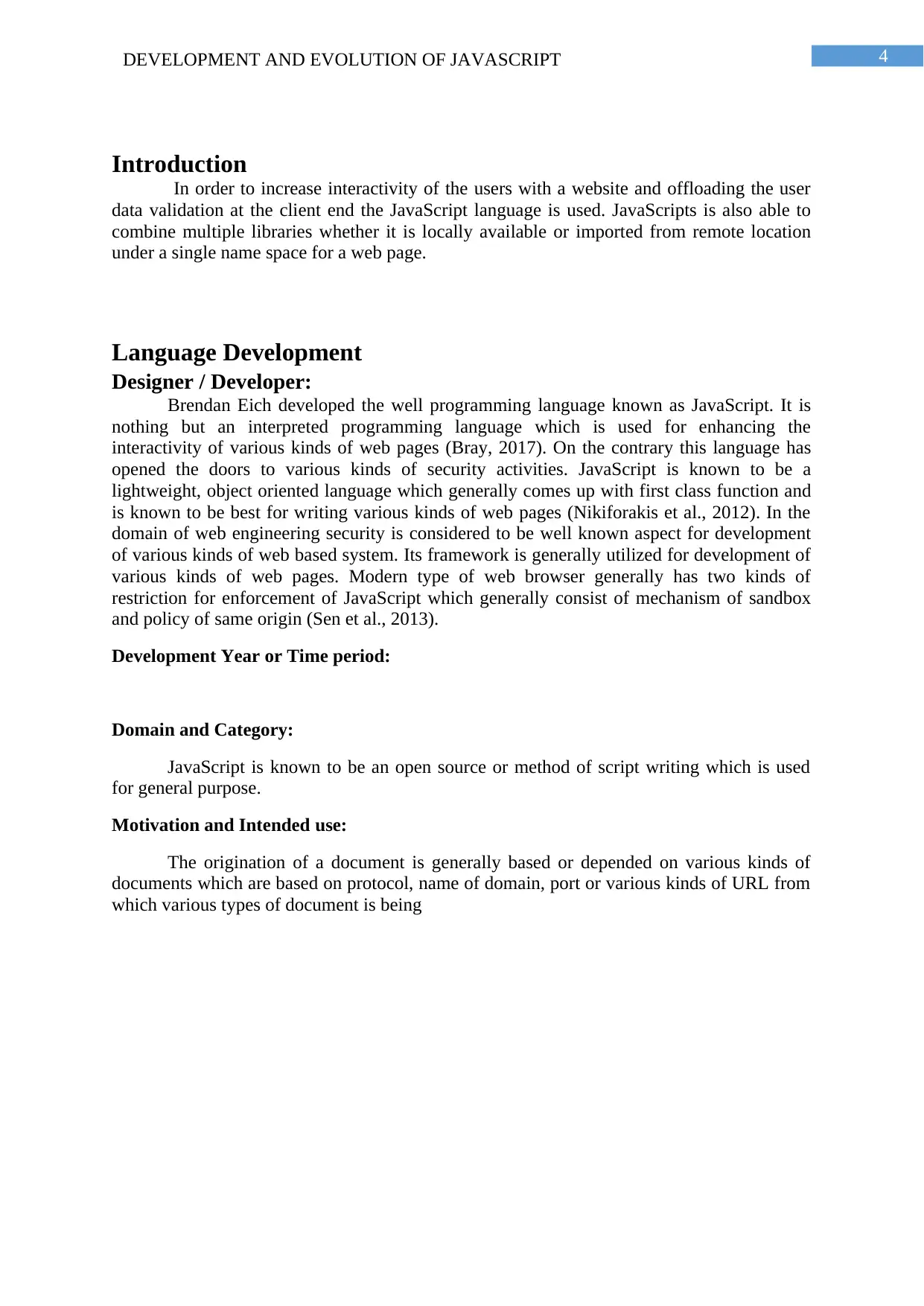
4DEVELOPMENT AND EVOLUTION OF JAVASCRIPT
Introduction
In order to increase interactivity of the users with a website and offloading the user
data validation at the client end the JavaScript language is used. JavaScripts is also able to
combine multiple libraries whether it is locally available or imported from remote location
under a single name space for a web page.
Language Development
Designer / Developer:
Brendan Eich developed the well programming language known as JavaScript. It is
nothing but an interpreted programming language which is used for enhancing the
interactivity of various kinds of web pages (Bray, 2017). On the contrary this language has
opened the doors to various kinds of security activities. JavaScript is known to be a
lightweight, object oriented language which generally comes up with first class function and
is known to be best for writing various kinds of web pages (Nikiforakis et al., 2012). In the
domain of web engineering security is considered to be well known aspect for development
of various kinds of web based system. Its framework is generally utilized for development of
various kinds of web pages. Modern type of web browser generally has two kinds of
restriction for enforcement of JavaScript which generally consist of mechanism of sandbox
and policy of same origin (Sen et al., 2013).
Development Year or Time period:
Domain and Category:
JavaScript is known to be an open source or method of script writing which is used
for general purpose.
Motivation and Intended use:
The origination of a document is generally based or depended on various kinds of
documents which are based on protocol, name of domain, port or various kinds of URL from
which various types of document is being
Introduction
In order to increase interactivity of the users with a website and offloading the user
data validation at the client end the JavaScript language is used. JavaScripts is also able to
combine multiple libraries whether it is locally available or imported from remote location
under a single name space for a web page.
Language Development
Designer / Developer:
Brendan Eich developed the well programming language known as JavaScript. It is
nothing but an interpreted programming language which is used for enhancing the
interactivity of various kinds of web pages (Bray, 2017). On the contrary this language has
opened the doors to various kinds of security activities. JavaScript is known to be a
lightweight, object oriented language which generally comes up with first class function and
is known to be best for writing various kinds of web pages (Nikiforakis et al., 2012). In the
domain of web engineering security is considered to be well known aspect for development
of various kinds of web based system. Its framework is generally utilized for development of
various kinds of web pages. Modern type of web browser generally has two kinds of
restriction for enforcement of JavaScript which generally consist of mechanism of sandbox
and policy of same origin (Sen et al., 2013).
Development Year or Time period:
Domain and Category:
JavaScript is known to be an open source or method of script writing which is used
for general purpose.
Motivation and Intended use:
The origination of a document is generally based or depended on various kinds of
documents which are based on protocol, name of domain, port or various kinds of URL from
which various types of document is being
Paraphrase This Document
Need a fresh take? Get an instant paraphrase of this document with our AI Paraphraser

5DEVELOPMENT AND EVOLUTION OF JAVASCRIPT
90%
5%
0% 5%
Javascript
Flash
SilverLIght
None
Language overview
Implementation method:
Features and constructs that characterize the language:
Feature of JavaScript:
Features Discussion
Object- Based languages
Light weight
Control statement
Looping statement
Case Sensitive
In-built function
Client side technology
Source code examples demonstrating various kinds of feature’s and general
programming
JavaScript method of validation. The HTML form of validation can be easily done by making
use of JavaScript. The code for this given below:
function validate Form()
90%
5%
0% 5%
Javascript
Flash
SilverLIght
None
Language overview
Implementation method:
Features and constructs that characterize the language:
Feature of JavaScript:
Features Discussion
Object- Based languages
Light weight
Control statement
Looping statement
Case Sensitive
In-built function
Client side technology
Source code examples demonstrating various kinds of feature’s and general
programming
JavaScript method of validation. The HTML form of validation can be easily done by making
use of JavaScript. The code for this given below:
function validate Form()
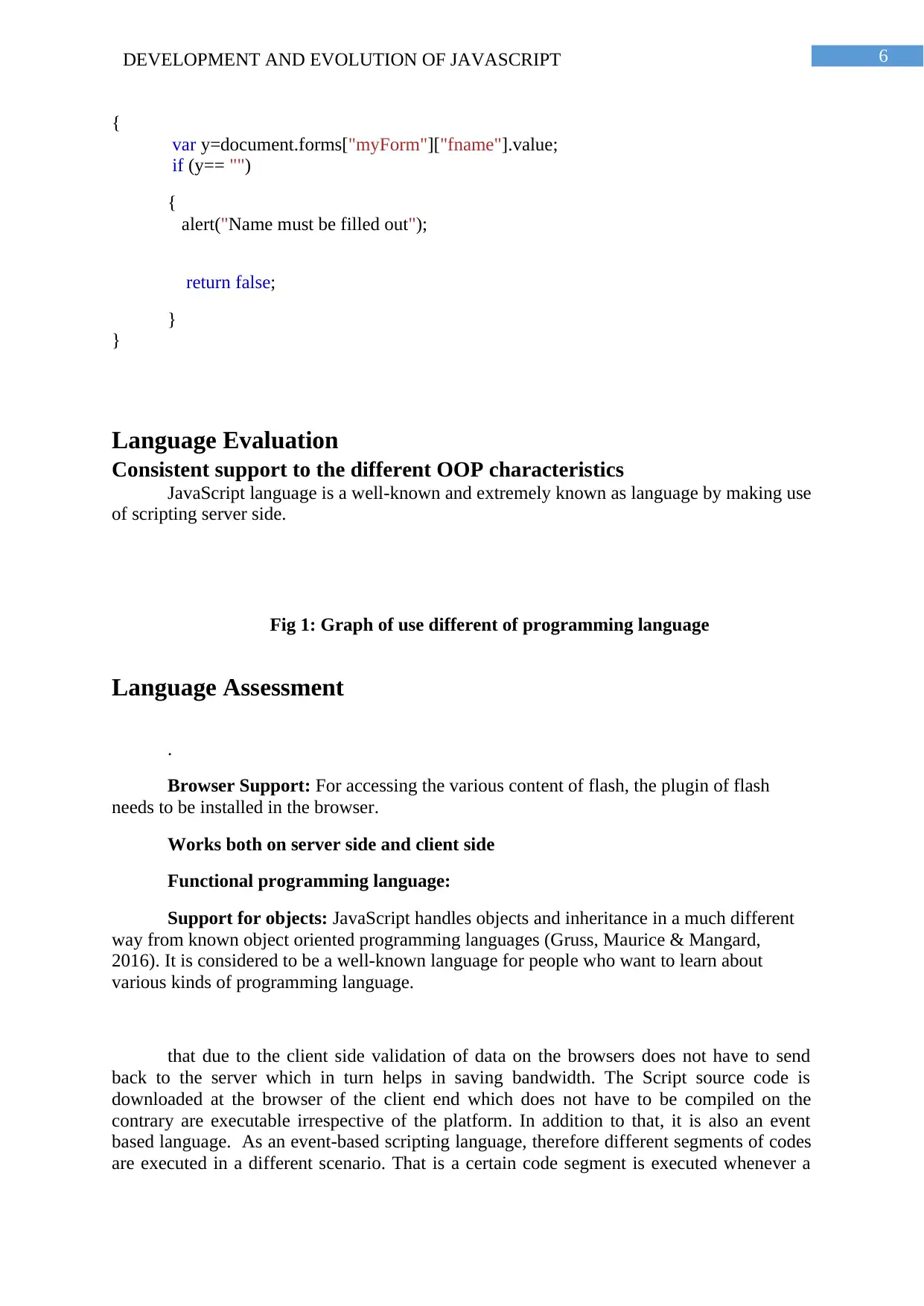
6DEVELOPMENT AND EVOLUTION OF JAVASCRIPT
{
var y=document.forms["myForm"]["fname"].value;
if (y== "")
{
alert("Name must be filled out");
return false;
}
}
Language Evaluation
Consistent support to the different OOP characteristics
JavaScript language is a well-known and extremely known as language by making use
of scripting server side.
Fig 1: Graph of use different of programming language
Language Assessment
.
Browser Support: For accessing the various content of flash, the plugin of flash
needs to be installed in the browser.
Works both on server side and client side
Functional programming language:
Support for objects: JavaScript handles objects and inheritance in a much different
way from known object oriented programming languages (Gruss, Maurice & Mangard,
2016). It is considered to be a well-known language for people who want to learn about
various kinds of programming language.
that due to the client side validation of data on the browsers does not have to send
back to the server which in turn helps in saving bandwidth. The Script source code is
downloaded at the browser of the client end which does not have to be compiled on the
contrary are executable irrespective of the platform. In addition to that, it is also an event
based language. As an event-based scripting language, therefore different segments of codes
are executed in a different scenario. That is a certain code segment is executed whenever a
{
var y=document.forms["myForm"]["fname"].value;
if (y== "")
{
alert("Name must be filled out");
return false;
}
}
Language Evaluation
Consistent support to the different OOP characteristics
JavaScript language is a well-known and extremely known as language by making use
of scripting server side.
Fig 1: Graph of use different of programming language
Language Assessment
.
Browser Support: For accessing the various content of flash, the plugin of flash
needs to be installed in the browser.
Works both on server side and client side
Functional programming language:
Support for objects: JavaScript handles objects and inheritance in a much different
way from known object oriented programming languages (Gruss, Maurice & Mangard,
2016). It is considered to be a well-known language for people who want to learn about
various kinds of programming language.
that due to the client side validation of data on the browsers does not have to send
back to the server which in turn helps in saving bandwidth. The Script source code is
downloaded at the browser of the client end which does not have to be compiled on the
contrary are executable irrespective of the platform. In addition to that, it is also an event
based language. As an event-based scripting language, therefore different segments of codes
are executed in a different scenario. That is a certain code segment is executed whenever a
⊘ This is a preview!⊘
Do you want full access?
Subscribe today to unlock all pages.

Trusted by 1+ million students worldwide
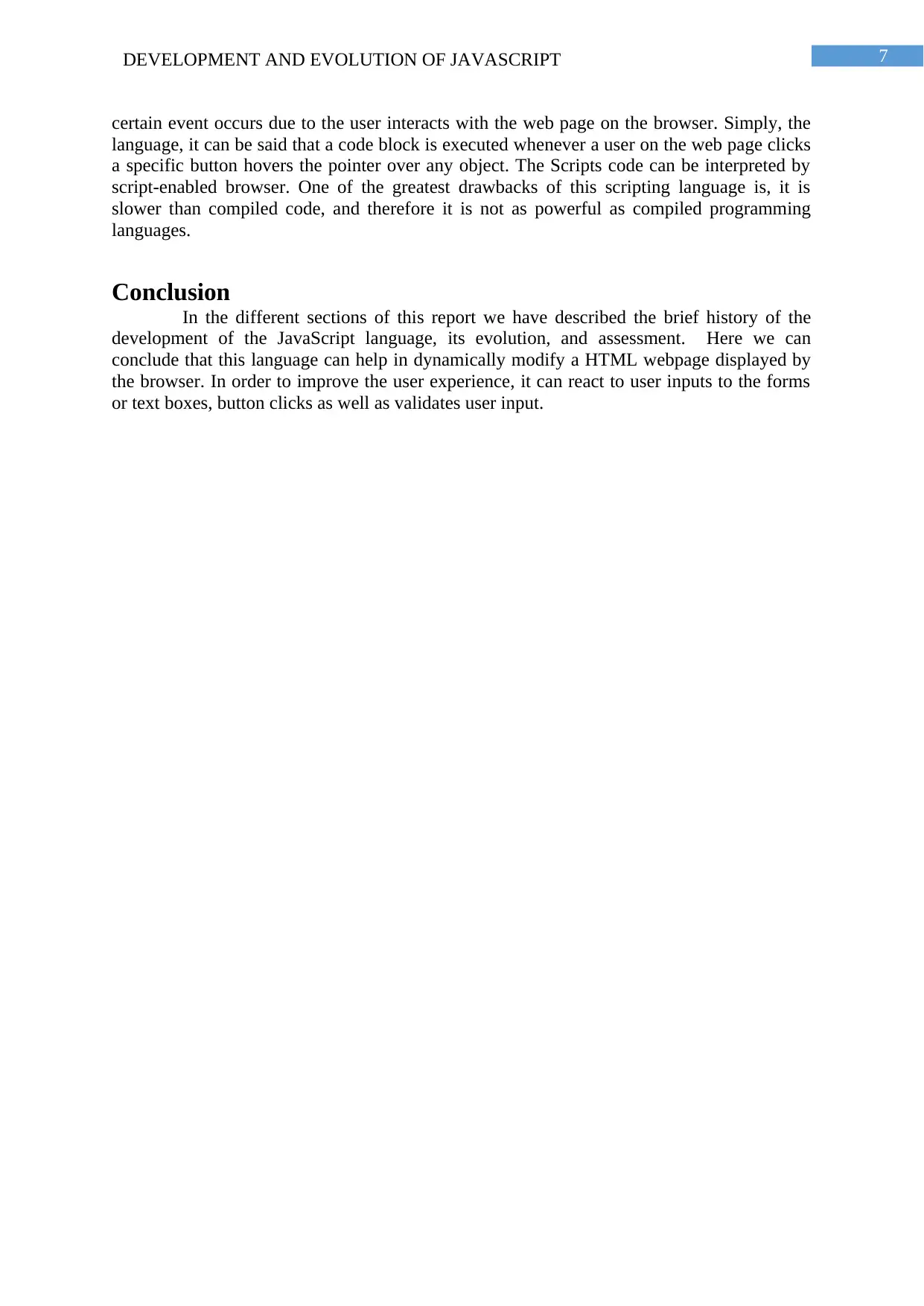
7DEVELOPMENT AND EVOLUTION OF JAVASCRIPT
certain event occurs due to the user interacts with the web page on the browser. Simply, the
language, it can be said that a code block is executed whenever a user on the web page clicks
a specific button hovers the pointer over any object. The Scripts code can be interpreted by
script-enabled browser. One of the greatest drawbacks of this scripting language is, it is
slower than compiled code, and therefore it is not as powerful as compiled programming
languages.
Conclusion
In the different sections of this report we have described the brief history of the
development of the JavaScript language, its evolution, and assessment. Here we can
conclude that this language can help in dynamically modify a HTML webpage displayed by
the browser. In order to improve the user experience, it can react to user inputs to the forms
or text boxes, button clicks as well as validates user input.
certain event occurs due to the user interacts with the web page on the browser. Simply, the
language, it can be said that a code block is executed whenever a user on the web page clicks
a specific button hovers the pointer over any object. The Scripts code can be interpreted by
script-enabled browser. One of the greatest drawbacks of this scripting language is, it is
slower than compiled code, and therefore it is not as powerful as compiled programming
languages.
Conclusion
In the different sections of this report we have described the brief history of the
development of the JavaScript language, its evolution, and assessment. Here we can
conclude that this language can help in dynamically modify a HTML webpage displayed by
the browser. In order to improve the user experience, it can react to user inputs to the forms
or text boxes, button clicks as well as validates user input.
Paraphrase This Document
Need a fresh take? Get an instant paraphrase of this document with our AI Paraphraser
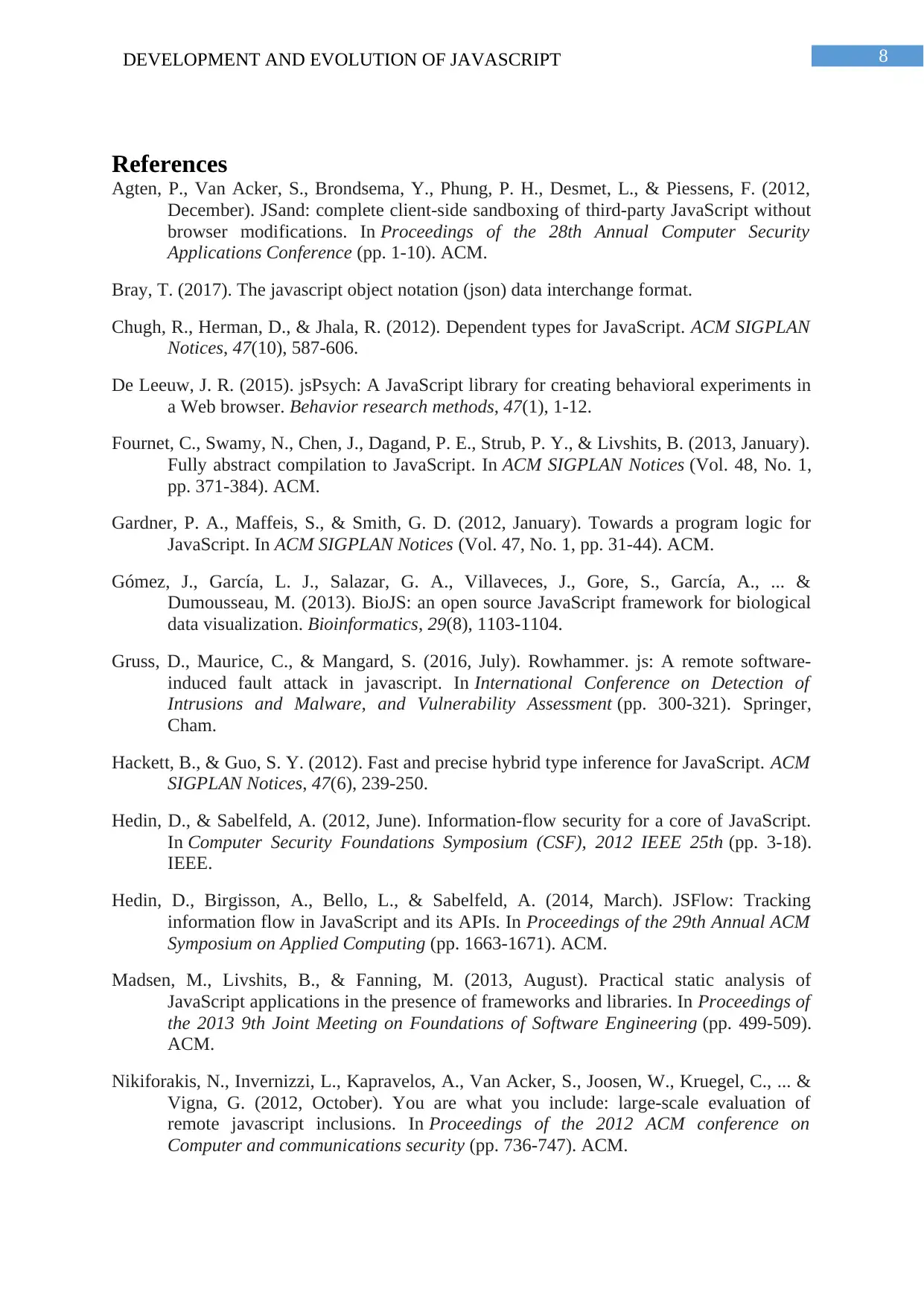
8DEVELOPMENT AND EVOLUTION OF JAVASCRIPT
References
Agten, P., Van Acker, S., Brondsema, Y., Phung, P. H., Desmet, L., & Piessens, F. (2012,
December). JSand: complete client-side sandboxing of third-party JavaScript without
browser modifications. In Proceedings of the 28th Annual Computer Security
Applications Conference (pp. 1-10). ACM.
Bray, T. (2017). The javascript object notation (json) data interchange format.
Chugh, R., Herman, D., & Jhala, R. (2012). Dependent types for JavaScript. ACM SIGPLAN
Notices, 47(10), 587-606.
De Leeuw, J. R. (2015). jsPsych: A JavaScript library for creating behavioral experiments in
a Web browser. Behavior research methods, 47(1), 1-12.
Fournet, C., Swamy, N., Chen, J., Dagand, P. E., Strub, P. Y., & Livshits, B. (2013, January).
Fully abstract compilation to JavaScript. In ACM SIGPLAN Notices (Vol. 48, No. 1,
pp. 371-384). ACM.
Gardner, P. A., Maffeis, S., & Smith, G. D. (2012, January). Towards a program logic for
JavaScript. In ACM SIGPLAN Notices (Vol. 47, No. 1, pp. 31-44). ACM.
Gómez, J., García, L. J., Salazar, G. A., Villaveces, J., Gore, S., García, A., ... &
Dumousseau, M. (2013). BioJS: an open source JavaScript framework for biological
data visualization. Bioinformatics, 29(8), 1103-1104.
Gruss, D., Maurice, C., & Mangard, S. (2016, July). Rowhammer. js: A remote software-
induced fault attack in javascript. In International Conference on Detection of
Intrusions and Malware, and Vulnerability Assessment (pp. 300-321). Springer,
Cham.
Hackett, B., & Guo, S. Y. (2012). Fast and precise hybrid type inference for JavaScript. ACM
SIGPLAN Notices, 47(6), 239-250.
Hedin, D., & Sabelfeld, A. (2012, June). Information-flow security for a core of JavaScript.
In Computer Security Foundations Symposium (CSF), 2012 IEEE 25th (pp. 3-18).
IEEE.
Hedin, D., Birgisson, A., Bello, L., & Sabelfeld, A. (2014, March). JSFlow: Tracking
information flow in JavaScript and its APIs. In Proceedings of the 29th Annual ACM
Symposium on Applied Computing (pp. 1663-1671). ACM.
Madsen, M., Livshits, B., & Fanning, M. (2013, August). Practical static analysis of
JavaScript applications in the presence of frameworks and libraries. In Proceedings of
the 2013 9th Joint Meeting on Foundations of Software Engineering (pp. 499-509).
ACM.
Nikiforakis, N., Invernizzi, L., Kapravelos, A., Van Acker, S., Joosen, W., Kruegel, C., ... &
Vigna, G. (2012, October). You are what you include: large-scale evaluation of
remote javascript inclusions. In Proceedings of the 2012 ACM conference on
Computer and communications security (pp. 736-747). ACM.
References
Agten, P., Van Acker, S., Brondsema, Y., Phung, P. H., Desmet, L., & Piessens, F. (2012,
December). JSand: complete client-side sandboxing of third-party JavaScript without
browser modifications. In Proceedings of the 28th Annual Computer Security
Applications Conference (pp. 1-10). ACM.
Bray, T. (2017). The javascript object notation (json) data interchange format.
Chugh, R., Herman, D., & Jhala, R. (2012). Dependent types for JavaScript. ACM SIGPLAN
Notices, 47(10), 587-606.
De Leeuw, J. R. (2015). jsPsych: A JavaScript library for creating behavioral experiments in
a Web browser. Behavior research methods, 47(1), 1-12.
Fournet, C., Swamy, N., Chen, J., Dagand, P. E., Strub, P. Y., & Livshits, B. (2013, January).
Fully abstract compilation to JavaScript. In ACM SIGPLAN Notices (Vol. 48, No. 1,
pp. 371-384). ACM.
Gardner, P. A., Maffeis, S., & Smith, G. D. (2012, January). Towards a program logic for
JavaScript. In ACM SIGPLAN Notices (Vol. 47, No. 1, pp. 31-44). ACM.
Gómez, J., García, L. J., Salazar, G. A., Villaveces, J., Gore, S., García, A., ... &
Dumousseau, M. (2013). BioJS: an open source JavaScript framework for biological
data visualization. Bioinformatics, 29(8), 1103-1104.
Gruss, D., Maurice, C., & Mangard, S. (2016, July). Rowhammer. js: A remote software-
induced fault attack in javascript. In International Conference on Detection of
Intrusions and Malware, and Vulnerability Assessment (pp. 300-321). Springer,
Cham.
Hackett, B., & Guo, S. Y. (2012). Fast and precise hybrid type inference for JavaScript. ACM
SIGPLAN Notices, 47(6), 239-250.
Hedin, D., & Sabelfeld, A. (2012, June). Information-flow security for a core of JavaScript.
In Computer Security Foundations Symposium (CSF), 2012 IEEE 25th (pp. 3-18).
IEEE.
Hedin, D., Birgisson, A., Bello, L., & Sabelfeld, A. (2014, March). JSFlow: Tracking
information flow in JavaScript and its APIs. In Proceedings of the 29th Annual ACM
Symposium on Applied Computing (pp. 1663-1671). ACM.
Madsen, M., Livshits, B., & Fanning, M. (2013, August). Practical static analysis of
JavaScript applications in the presence of frameworks and libraries. In Proceedings of
the 2013 9th Joint Meeting on Foundations of Software Engineering (pp. 499-509).
ACM.
Nikiforakis, N., Invernizzi, L., Kapravelos, A., Van Acker, S., Joosen, W., Kruegel, C., ... &
Vigna, G. (2012, October). You are what you include: large-scale evaluation of
remote javascript inclusions. In Proceedings of the 2012 ACM conference on
Computer and communications security (pp. 736-747). ACM.
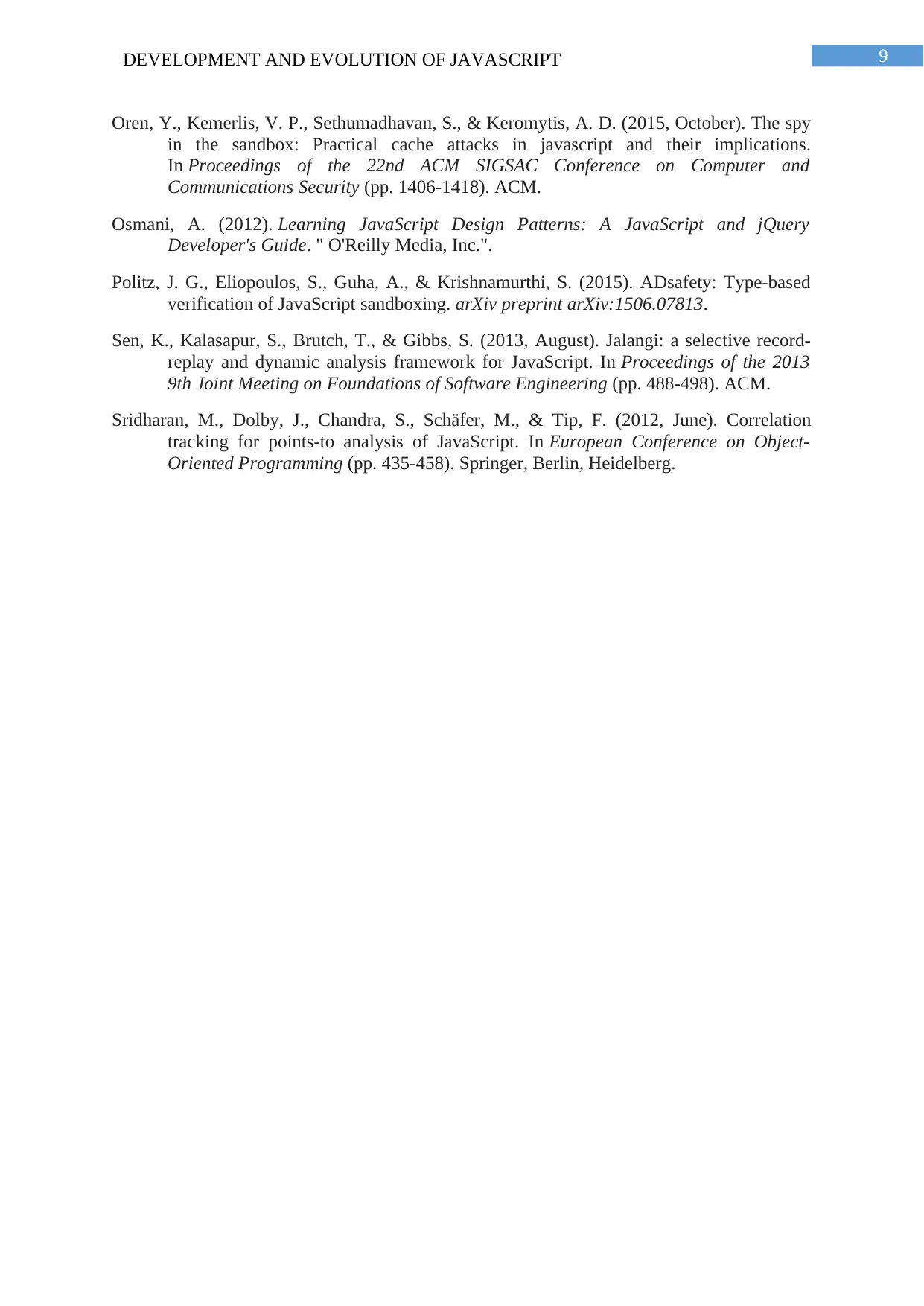
9DEVELOPMENT AND EVOLUTION OF JAVASCRIPT
Oren, Y., Kemerlis, V. P., Sethumadhavan, S., & Keromytis, A. D. (2015, October). The spy
in the sandbox: Practical cache attacks in javascript and their implications.
In Proceedings of the 22nd ACM SIGSAC Conference on Computer and
Communications Security (pp. 1406-1418). ACM.
Osmani, A. (2012). Learning JavaScript Design Patterns: A JavaScript and jQuery
Developer's Guide. " O'Reilly Media, Inc.".
Politz, J. G., Eliopoulos, S., Guha, A., & Krishnamurthi, S. (2015). ADsafety: Type-based
verification of JavaScript sandboxing. arXiv preprint arXiv:1506.07813.
Sen, K., Kalasapur, S., Brutch, T., & Gibbs, S. (2013, August). Jalangi: a selective record-
replay and dynamic analysis framework for JavaScript. In Proceedings of the 2013
9th Joint Meeting on Foundations of Software Engineering (pp. 488-498). ACM.
Sridharan, M., Dolby, J., Chandra, S., Schäfer, M., & Tip, F. (2012, June). Correlation
tracking for points-to analysis of JavaScript. In European Conference on Object-
Oriented Programming (pp. 435-458). Springer, Berlin, Heidelberg.
Oren, Y., Kemerlis, V. P., Sethumadhavan, S., & Keromytis, A. D. (2015, October). The spy
in the sandbox: Practical cache attacks in javascript and their implications.
In Proceedings of the 22nd ACM SIGSAC Conference on Computer and
Communications Security (pp. 1406-1418). ACM.
Osmani, A. (2012). Learning JavaScript Design Patterns: A JavaScript and jQuery
Developer's Guide. " O'Reilly Media, Inc.".
Politz, J. G., Eliopoulos, S., Guha, A., & Krishnamurthi, S. (2015). ADsafety: Type-based
verification of JavaScript sandboxing. arXiv preprint arXiv:1506.07813.
Sen, K., Kalasapur, S., Brutch, T., & Gibbs, S. (2013, August). Jalangi: a selective record-
replay and dynamic analysis framework for JavaScript. In Proceedings of the 2013
9th Joint Meeting on Foundations of Software Engineering (pp. 488-498). ACM.
Sridharan, M., Dolby, J., Chandra, S., Schäfer, M., & Tip, F. (2012, June). Correlation
tracking for points-to analysis of JavaScript. In European Conference on Object-
Oriented Programming (pp. 435-458). Springer, Berlin, Heidelberg.
⊘ This is a preview!⊘
Do you want full access?
Subscribe today to unlock all pages.

Trusted by 1+ million students worldwide
1 out of 9
Related Documents
Your All-in-One AI-Powered Toolkit for Academic Success.
+13062052269
info@desklib.com
Available 24*7 on WhatsApp / Email
![[object Object]](/_next/static/media/star-bottom.7253800d.svg)
Unlock your academic potential
Copyright © 2020–2025 A2Z Services. All Rights Reserved. Developed and managed by ZUCOL.





